| This article needs additional citations for verification. Please help improve this article by adding citations to reliable sources. Unsourced material may be challenged and removed. Find sources: "Mangalia" – news · newspapers · books · scholar · JSTOR (August 2023) (Learn how and when to remove this message) |
Municipality in Constanța, Romania
| Mangalia | |
|---|---|
| Municipality | |
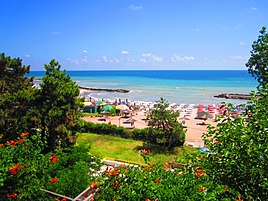 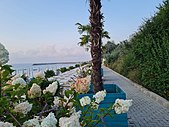  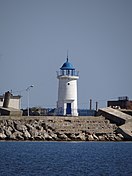 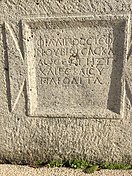
| |
 Coat of arms Coat of arms | |
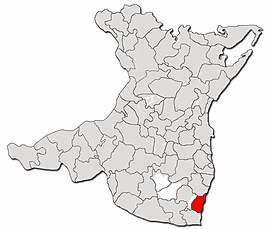 Location in Constanța County Location in Constanța County | |
 | |
| Coordinates: 43°49′02″N 28°34′58″E / 43.81722°N 28.58278°E / 43.81722; 28.58278 | |
| Country | Romania |
| County | Constanța |
| Government | |
| • Mayor (2020–2024) | Cristian Radu (PNL) |
| Area | 62.26 km (24.04 sq mi) |
| Elevation | 20 m (70 ft) |
| Population | 31,950 |
| • Density | 510/km (1,300/sq mi) |
| Time zone | EET/EEST (UTC+2/+3) |
| Vehicle reg. | CT |
| Website | www |
Mangalia (Romanian pronunciation: [maŋˈɡali.a] , Turkish: Mankalya), ancient Callatis (Greek: Κάλλατις/Καλλατίς; other historical names: Pangalia, Panglicara, Tomisovara), is a city and a port on the coast of the Black Sea in the south-east of Constanța County, Northern Dobruja, Romania.
The municipality of Mangalia also administers several summertime seaside resorts: Cap Aurora, Jupiter, Neptun, Olimp, Saturn, Venus.
History
See also: DobrujaThe Greek colony of Callatis was founded in the 6th century BC by the city of Heraclea Pontica. Like the other Greek cities on the coast nearby, it became a Greek city-state with its own chora (territory) which included the fortified settlement of Albesti 15km distant. Its first silver coinage was minted around 350 BC.
The Macedonians invaded the area from 339 BC against which Callatis and the nearby Greek cities revolted leading to the siege of the city in 313-311 by Lysimachus and its reoccupation.
In 72 BC, Callatis was conquered by the Roman general Lucullus and was assigned to the Roman province of Moesia Inferior. Throughout the 2nd century AD, the city built defensive fortifications and the minting of coinage under the Roman emperors Septimius Severus and Caracalla continued. Callatis suffered multiple invasions in the 3rd century but recovered in the 4th century to regain its status as an important trade hub and port city. From the 7th to the 11th century the city was under the rule of the First Bulgarian Empire.
Callatis existed until the mid-7th century under this name. Life in the town resumed from the 10th century. In the 13th century Callatis came to be known as Pangalia. The Vlachs called it Tomisovara and the Greeks called it Panglicara. From the 16th century the town had acquired its present name, Mangalia.
Between March and July 1878 the city of Mangalia was part of Bulgaria according to the Treaty of San Stefano. In July 1878 the Congress of Berlin modified the Treaty of San Stefano. According to Article XLVI the Bulgaria–Romania border in Dobrudja was defined as "a line starting from the east of Silistra and terminating on the Black Sea, south of Mangalia."
Sights
A Roman Byzantine building has been excavated against the city wall and next to a street paved with big limestone tiles and which has a channel on its longitudinal axis. It is composed of an atrium with a complex system for collecting rainwater, a palace composed of monumental halls with columns and a basilica. It was probably a bishop's palace.
Geography and climate
Mangalia is positioned at 43°49’ latitude and 28°35’ longitude, with an approximate elevation of 10 meters, 44 kilometres (27 miles) south of the municipality of Constanţa, on the same latitude as the French resort of Nice. Mangalia is one of the southernmost resorts on the Romanian coast of the Black Sea.
Mangalia is characterized by a moderate maritime climate (annual average temperature 11 °C (52 °F) - one of the highest in Romania) with hot summers (July average over 21 °C (70 °F)) and mild winters (January average 1 °C (34 °F)), Mangalia being the country's second place, after Băile Herculane, with positive average temperatures in wintertime. Spring comes early but is cool and autumn is long and warm. In summer, cloudiness is reduced (about 25 sunny days in a month) and the duration of sunshine is of 10–12 hours a day. Annual precipitation is low (about 400 mm (16 in)).
The sea breeze is stronger in summer. The natural cure factors are the water of the Black Sea, which is chlorided, sulphated, sodic, magnesian, hypotonic (mineralization 15.5g), the sulphurous, chlorided, bicarbonated, sodic, calcic, mesothermal (21-28 °C) mineral waters of the springs in the northern part of the city, in the area of the beach between Saturn and Venus, the sulphurous peat mud, rich in minerals, which is extracted from the peat bog north of the city (expected to last another 250 years) and the marine climate, rich in saline aerosols and solar radiation that have a bracing effect on the organism.
The resort has a large, fine-sand beach developed for purposes of aeroheliotherapy and wave therapy, as well as high seawalls with a specific microclimate where one may benefit from inhalations of saline aerosols having therapeutic effects.
| Climate data for Mangalia | |||||||||||||
|---|---|---|---|---|---|---|---|---|---|---|---|---|---|
| Month | Jan | Feb | Mar | Apr | May | Jun | Jul | Aug | Sep | Oct | Nov | Dec | Year |
| Mean daily maximum °C (°F) | 5 (41) |
6 (43) |
9 (48) |
13 (55) |
19 (66) |
23 (73) |
26 (79) |
26 (79) |
22 (72) |
17 (63) |
11 (52) |
7 (45) |
15 (59) |
| Mean daily minimum °C (°F) | −2 (28) |
−1 (30) |
2 (36) |
7 (45) |
12 (54) |
16 (61) |
18 (64) |
18 (64) |
14 (57) |
10 (50) |
4 (39) |
1 (34) |
8 (46) |
| Source: Weatherbase | |||||||||||||
Demographics
| Year | Pop. | ±% |
|---|---|---|
| 1912 | 1,929 | — |
| 1930 | 2,764 | +43.3% |
| 1948 | 4,547 | +64.5% |
| 1956 | 4,792 | +5.4% |
| 1966 | 12,674 | +164.5% |
| 1977 | 26,821 | +111.6% |
| 1992 | 43,960 | +63.9% |
| 2002 | 40,037 | −8.9% |
| 2011 | 36,364 | −9.2% |
| 2021 | 31,950 | −12.1% |
| Source: Census data | ||
At the 2021 census Mangalia had a population of 31,950 with a majority of Romanians (74.27%) and minorities of Tatars (3.07%), Turks (2.01%), Lipovans (0.19%), Roma (0.18%), Hungarians (0.13%), Bulgarians (0.01%), others (0.78%) and unknown (19.36%).
At the 2011 census Mangalia had a population of 36,364 with a majority of Romanians (82.4%) and minorities of Turks (4.05%), Tatars (3.25%), Roma (0.45%), Lipovans (0.32%), Hungarians (0.23%), others (0.14%) and unknown (9.16%).
According to the religion of the respondents for whom data is available, 89.5% were Romanian Orthodox, 8.3% Muslim, 0.9% Roman Catholic, 0.3% Pentecostal, and 1% other or none.
Tourist attractions
- The city has been well known in recent years as the place where one of the largest summer festivals in Romania takes place: Callatis Festival;
- The Scythian tomb discovered in 1959 where archaeologists unearthed fragments of a papyrus in Greek, the first document of this kind in Romania;
- The incineration tombs (the necropolis of the Callatis citadel, dating back to the 4th-2nd centuries BC);
- The ruins of the Callatis citadel (6th century BC);
- The Turkish Esmahan Sultan Mosque (16th century);
- The Archaeology Museum which shelters a rich collection of amphorae and sculptures from the Hellenistic epoch, fragments of stone sarcophagi;
- Mangalia Marina
Gallery
-
 4th-/7th-century Roman-Byzantine archaeological display from the ancient city of Callatis, housed in the basement of Hotel New Belvedere
4th-/7th-century Roman-Byzantine archaeological display from the ancient city of Callatis, housed in the basement of Hotel New Belvedere
-
 Esmahan Sultan Mosque
Esmahan Sultan Mosque
-
 Marina
Marina
-
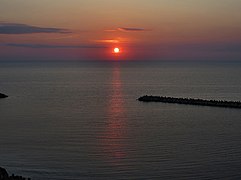 Sunrise in Mangalia
Sunrise in Mangalia
-
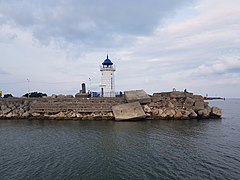 Genoese Lighthouse
Genoese Lighthouse
-
 Still from Mangalia, downtown
Still from Mangalia, downtown
Natives
- Denis Alibec (born 1991), footballer
- Andreea Ana (born 2000), freestyle wrestler
- Marius Antonescu (born 1992), rugby union player
- Florin Bejan (born 1991), footballer
- Radu Doicaru (born 1979), footballer
- Inna (born 1986), singer
- Mihai Lămboiu (born 1997), rugby union player
- Rareș Murariu (born 1999), footballer
- Claudia Pavel (born 1984), pop singer and dancer
- Antoaneta Sabău (born 1982), classicist, translator, and editor
- Satyrus the Peripatetic (c. 3rd century BC), Greek peripatetic philosopher and historian
- Gheorghe Vitanidis (1929–1994), film director
Politics
The current mayor of Mangalia is Cristian Radu (PNL).
The Mangalia Municipal Council, elected in the 2020 local government elections, is made up of 19 councilors, with the following party composition:
| Party | Seats | Current Council | ||||||||||
|---|---|---|---|---|---|---|---|---|---|---|---|---|
| National Liberal Party (PNL) | 10 | |||||||||||
| PSD+ALDE+PNȚCD | 5 | |||||||||||
| Ecologist Party of Romania (PER) | 3 | |||||||||||
| PRO Romania (PRO) | 1 | |||||||||||
International relations
See also: List of twin towns and sister cities in RomaniaMangalia is twinned with:
 Aywaille, Belgium
Aywaille, Belgium Balchik, Bulgaria
Balchik, Bulgaria Banská Bystrica, Slovakia
Banská Bystrica, Slovakia Byblos, Lebanon
Byblos, Lebanon Charleville-Mézières, France
Charleville-Mézières, France General Toshevo, Bulgaria
General Toshevo, Bulgaria Greenport, United States
Greenport, United States Karmiel, Israel
Karmiel, Israel Laurium, Greece
Laurium, Greece Pale, Bosnia and Herzegovina
Pale, Bosnia and Herzegovina Porto Viro, Italy
Porto Viro, Italy Santa Severina, Italy
Santa Severina, Italy Struga, North Macedonia
Struga, North Macedonia
References
- ^ "Results of the 2020 local elections". Central Electoral Bureau. Archived from the original on 9 October 2020. Retrieved 15 June 2021.
- "Populaţia rezidentă după grupa de vârstă, pe județe și municipii, orașe, comune, la 1 decembrie 2021" (XLS). National Institute of Statistics.
- Ewa Stanecka, Callatis as a Seaport, Studies in Ancient Art and Civilisation, 10.12797/SAAC.17.2013.17.28, 17, (325-333), (2013)
- Diodorus XIX, 73
- Michael Grant, A Guide to the Ancient World, New York: Barnes and Noble Books 1997, p. 140.
- Preda, C. 1968: Callatis. Bucharest.
- ^ Innocenzi, Alfredo (1 March 2016). Dobrogea:o frontiera uitata (in Romanian). Youcanprint. ISBN 9788893328678.
- "Bulgaria in the borders after the Treaties of Constantipole, San Stefano, Berlin, London, Bucharest and Neuilly".
- "International Boundary Study No. 53. Bulgaria – Romania (Rumania) Boundary" (PDF), library.law.fsu.edu, United States Department of State, p. 6, 30 June 1965, retrieved 10 July 2024
- "Weatherbase data Mangalia". Archived from the original on 2 April 2019. Retrieved 21 October 2008.
- "Populația rezidentă după grupa de vârstă, pe județe și municipii, orașe, comune, la 1 decembrie 2021" (in Romanian). INSSE. 31 May 2023. Archived from the original on 26 June 2023. Retrieved 24 October 2023.
- "Orase infratite". mangalia.ro (in Romanian). Mangalia. Archived from the original on 8 February 2023. Retrieved 25 October 2019.
- Alexandru Avram. Kallatis. - In: Ancient Greek Colonies in the Black Sea. Vol. 1. Eds. Dimitrios V. Grammenos and Elias K. Petropoulos. Oxford, Archaeopress, 2001 (BAR International Series; 1675 (1-2)), 239–286.
| Romanian Black Sea resorts | |
|---|---|
- Mangalia
- Populated places established in the 6th century BC
- Greek colonies in Scythia Minor
- Populated places in Constanța County
- Localities in Northern Dobruja
- Populated coastal places in Romania
- Cities in Romania
- Port cities and towns in Romania
- Spa towns in Romania
- Byzantine sites in Romania
- Roman towns and cities in Romania
